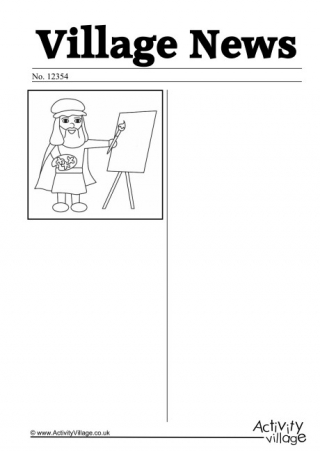Leonardo da Vinci (1452–1519) is remembered as one of the world’s most talented people. During his lifetime, he was known as a great Italian artist. Then, after his death, his journals revealed yet more astonishing skills – he was also an inventor and scientist far beyond his time. Learn more about this remarkable man and use our collection of printable resources below to test your knowledge.

Fun Facts
Leonardo da Vinci was left-handed. Some people say he could paint with one hand and write at the same time with the other! He also used to write backwards, from right to left across the page. For many years, people found it difficult to understand his journals – until they used a mirror to read them. Perhaps Leonardo was deliberately trying to keep his ideas secret!
Leonardo da Vinci Quotes
“The noblest pleasure is the joy of understanding.”
“When once you have tasted flight, you will forever walk the earth with your eyes turned skyward, for there you have been, and there you will always long to return.”
“Painting is poetry that is seen rather than felt, and poetry is painting that is felt rather than seen.”
A Short Biography of Leonardo da Vinci
Leonardo da Vinci was born in Vinci, a town near Florence, Italy, in 1452. His father was a wealthy man and his mother was a peasant girl. Leonardo’s parents never married but his father had several wives. Leonardo had many half brothers and sisters from these relationships.
As a child, Leonardo was educated at home. His father also encouraged him to paint and draw. He showed exceptional artistic talent at a young age and his father was keen to develop this talent. When Leonardo was 14, he was sent to work as an apprentice for a well-known Florentine artist named Verrocchio. It was here that Leonardo learnt many of the skills he would later use in his paintings, drawings and sculptures.
In his twenties, Leonardo set up his own art studio and began working on church paintings and other commissions. Then, in 1482, he went to work for the Duke of Milan – a position he held for 17 years. The duke commissioned Leonardo to produce religious paintings and sculptures and to design buildings and bridges. It was during this time that Leonardo painted The Last Supper, a wall mural showing the last days of Jesus’ life. For this masterpiece, Leonardo experimented with oils, but the paint began to flake off the walls. Today, The Last Supper can be found in a convent in Milan, Italy, although the painting is largely a reconstruction of the original.

Leonardo da Vinci's The Last Supper
When the French invaded Milan in 1499, the duke fell from power. Leonardo returned to Florence and it was here that he worked on one of his most famous paintings, the Mona Lisa. This portrait of the wife of a Florentine official has been in the Louvre gallery in Paris for over 200 years.

Leonardo da Vinci's Mona Lisa
Leonardo loved to paint what he saw in the world around him, but was also fascinated by how things worked. He was given permission, for example, to dissect and study human bodies in detail. He made many drawings and diagrams of the bones, muscles and internal organs he found. One of his most famous scientific sketches is the Vitruvian Man, a drawing that shows the ideal proportions of the human body.
Leonardo also studied the flight of birds and drew designs for flying machines that looked very like modern-day hang gliders and helicopters. He also drew what appeared to be boats, bicycles and other vehicles. Many of these ideas were ahead of his time, and there was no technology available to build them.
In 1516, King Francois I of France asked Leonardo to be his artist in residence and gave him a manor house. Leonardo spent the last three years of his life in France. During this time, he suffered a stroke that paralysed his right hand. This loss of mobility in his last years left him unable to organise his drawings and ideas. He died shortly after his 67th birthday. It was many years before the 13,000 pages of his journals were discovered and his talents fully realised.
Our Leonardo da Vinci Resources


























